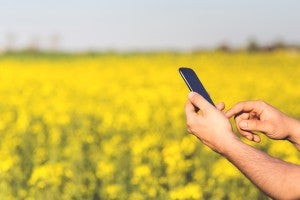 Data science in farm management is one of the biggest trends to hit both agriculture and Silicon Valley in recent years, with an explosion of technologies emerging to help farmers optimize everything from seeding to irrigation to fertilizer application.
Data science in farm management is one of the biggest trends to hit both agriculture and Silicon Valley in recent years, with an explosion of technologies emerging to help farmers optimize everything from seeding to irrigation to fertilizer application.
As ag tech products grow more sophisticated, so too has the innovation trend evolved. What began as a slew of single-purpose tools has now evolved to include apps that integrate different types of information to give farmers a “dashboard” view of their land. And it includes new apps that can help multiple farmers pool their data to analyze a crop’s performance across a range of growing conditions, or to benchmark their input costs against one another.
The agriculture sector stands to gain insight from all this data. Farmers need metrics to help them figure out how to increase yields sustainably while improving soil health and protecting natural resources for future generations.
But they have valid concerns about sharing data.
With the plethora of technology companies and organizations ready to use farm data, how can farmers protect the information collected from their fields? What if it winds up in the hands of competitors? Could a farmer’s competitive edge in planting practices, fertilizer use or pricing be revealed?
[Tweet “Why privacy is an essential piece of agriculture’s big-data revolution, via @KennethQin @GrowingReturnshttps://edf.org/7pg”]
The need for standards
 Agriculture does not yet have a single, agreed upon data privacy standard or set of protocols. Instead farmers have to negotiate data contracts with every ag tech provider with whom they wish to work.
Agriculture does not yet have a single, agreed upon data privacy standard or set of protocols. Instead farmers have to negotiate data contracts with every ag tech provider with whom they wish to work.
Key to the protection of farmers’ privacy in any data-sharing endeavor is the process of “anonymizing” the data, or “scrubbing” it. In that process, the data is separated from any personal information such as name, address or geographic identifiers more precise than the county level.
When anonymization is followed by aggregation – the grouping together of information from, say, all corn farmers in a given state or broad geographic region – the two usually provide adequate privacy protection.
Nonetheless, the lack of formal standards for privacy and security could keep farmers from adopting new technologies with confidence.
Significant parts of agriculture already experience big data sharing. For instance, the Federal Crop Insurance Program bases its pricing models on data from the National Agricultural Statistics Survey collected by the USDA’s Risk Management Association. From that process come crop insurance payments. In order for these models to generate fair prices, they must receive ample and accurate data – which could follow from better security standards.
Secure data sharing in action
Beet farmers in Denmark have been using a secure data-sharing protocol since 2008 to negotiate the annual nationwide price for grower contracts, without revealing their personal bid prices to anyone – not even a third-party intermediary.
Instead, the personal bids are distributed anonymously among all involved parties in a privacy-preserving manner, so that each party can arrive at the same market-clearing price. This gets around the age-old problem of finding an impartial entity that everyone trusts to hold sensitive information in confidence.
Many people are trying to develop data privacy and security standards. As reliable standards emerge, they can help farmers more easily feed a growing population while sustaining the natural systems we all need to survive.
Related:
Who will protect farmers’ privacy in the big data boom? >>
Why collaboration between ag equipment and tech companies is a good thing for the environment >>
A reality check on the drones boom >>









